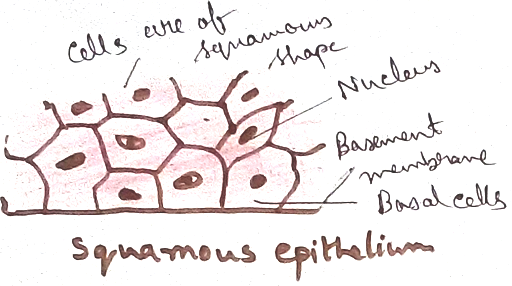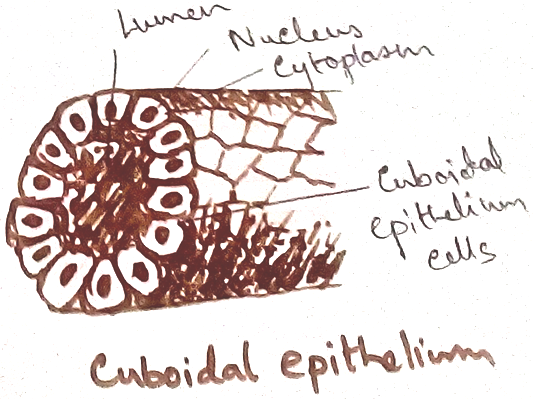Animal Tissues and Their Four Types
Animal Tissues: Animal tissues can be divided into four groups according to their functions. They are epithelial tissue, muscular tissue, connective tissue and nervous tissue.
Epithelial Tissues: These tissues are very closely packed and form a continuous protective layer over the surface of organs and inner lining of the body cavity.
There are different types of epithelial tissues. They are divided according to the shape –
Simple Epithelial Tissue:
This is unilayer, unilaminar, unstratified epithelium.
Squamous epithelial tissues - It is called pavement epithelial cells because the cells of squamous epithelial are flat, polygonal, and fitted like the tiles of the floor.
Cubical or cuboidal epithelial tissue - polygonal in shape. Examples are lining of smaller salivary ducts, pancreatic ducts, brush border.
Cilliated Epithelial Tissue - Free surface that bears cilia. Cubical cilliated epithelium (certain parts of uniferous tubule), columned Ciliated epithelium (bronchioles,small bronchi).
Pseudostratified epithelial tissues - Lining layer of nasal chambers,trachea and large bronchi.
Modified epithelial tissue – Ducts and glandular portions of gland.
Columnar epithelial tissues – Layer of intestinal mucosa.
Compound epithelium or stratified epithelium:
Stratified squamous epithelium- epidermis of skin.
Stratified cuboidal epithelium – mammary gland, ducts of sweat gland,larger salivary, pancreatic duct.
Stratified columned epithelium- epiglottis covering, part of urethra.
Stratified Ciliated epithelium- larynx.
Transitional epithelium:
It is stretchable epithelium where cell replacement can take place at any level.Examples – lining layer of renal pelvis, ureter and urinary bladder. Basement membrane is not present.
Glands:
It is unicellular or multicellular glands. This included exocrine glands, endocrine glands, heterocrine glands, merocrine glands, apocrine glands, holocrine glands.
Functions of epithelial tissues are:
1. Primary function of epithelial tissue is to give protection over the different layers and inner lining of the different body parts.
2. Epithelial tissues are associated with secretion, selective absorption and sensation.
Connective Tissue: –It is mesodermal in origin. Connective tissue is made up of matrix (abundant intercellular substances or ground substances) and living cell which connect and supports different tissues. Depending upon the matrix, it is of three types-
Connective Tissue proper – semisolid or semi fluid matrix.
Supportive connective tissue- Rigid and solid matrix. Example- skeletal tissue.
Fluid connective tissue- fluid matrix . That is vascular tissues.
Different type of connective tissues are-
Areolar tissues- allows movement of parts connected by it.
Adipose tissue - specialised to store fat.
White fibrous tissue - perichondrium, periosteum.
Yellow fibrous tissue - bronchioles, wall of blood vessels.
Tendon – attach muscles with bones.
Ligament – attach bones with bones.
Reticular tissues – bone marrow, thymus, lymph,nodes etc.
Mucous connective tissue - umbelicak cord, vitreous humour.
Cartilage – Matrix is secreted by chondroblast. It is semirigid supportive or skeletal connective tissue in which the matrix is made up of mucoprotein called chondrin. It is of four types –
Hyaline cartilage –
White Fibro- Cartilage –
Elastic cartilage-
Calcified cartilage-
Bone – Hardest tissue of the body. It consists of solid rigid matrix, indistinguishable fibres, bone cells (osteocytes). Matris is made up of calcium phosphate, calcium carbonate, magnesium phosphate, chloride and fluoride.
Blood – Blood is the mobile connective tissue that is derived from mesoderm. It flows inside the blood vessels and human body contains five litres of blood. It contains plasma portion and formed elements.
Plasma - Matrix part of the blood is called plasma.90- 92% of the portion of matrix is made up of water. It consists of protein, nutrients, cholesterol, anticoagulant, hormone, excretory products, inorganic substance.
Formed elements – Formed elements are erythrocytes (carry oxygen in the blood), leucocytes (provide immunity) and blood platelets (responsible for blood coagulation).
Neuroglia –Connective tissue of central nervous system.
Muscular tissue or contractile tissue: It is a mesodermal tissue devoid of matrix, the cells are hold together by matrix and specialized for contraction. Individual muscle cells are called muscle fibre. A group of muscles fibre held together by endomysium (in fasciculi), perimysium (around fasciculi) and epimysium (around whole muscle) is formed muscle.
It consists of –proteinaceous fibrils called myofibril , calcium ion, magnesium ion and ATP are required internally for muscle contraction.
Muscle fibres are of three types:
Striated muscle fibres – they are cylindrical, unbranched, striped, skeletal, voluntary muscle. Part of myofibrils between adjacent Z-line functionas a unit of contraction. It is called sarcomere. It comprises one full A- band and two half I- bands. This region consist of two types of protein filaments called actin and myosin.
Un striated muscle fibres – It is non striated,un striped, smooth or involuntary muscle fibres. They are slow in contraction but they never get fatigue and can continue for long term. Wall of large blood vessels , ciliary, iris muscle of eye, arrector pilli contains a group of multi unit smooth muscle. Muscles of urinary bladder wall , gastrointestinal intestinal tract contains single unit smooth muscle.
Cardiac muscle fibres – they are involuntary, striated, nonfatigued, uninucleate,placed end to end rows as well as develop cross connections through lateral out growth. Intercalated discs or zig-zag junctions occur in between two cells.
Nervous tissue: A tissue that originate from ectodermal origin , associated with reception, integration and transmission of stimuli and does not have matrix , whereas cells are attached by special connective tissue is called nervous tissue. Nerve cells are called neurones.
A neurone is a unit of nerve cell which is differentiated into two parts - cell body and axon.
Cell body – Cell body is surrounded by plasma lemma, contains a central nucleus, mitochondria, endoplasmic reticulum, ribosomes, lysosome,oil globules.Outside the cell body bears some small tapering protoplasmic outgrowth called dendrons. Branches of dendron are called dendrite. Dendron contain both Nissl granules and neurofibrils that transmit stimuli to cell body.
Axon – Axon is the fibre like processesthat develop from the cell body through a conical area called axolemma. Nissl granules,Golgi body, ribosome and oil globules are absent.
Depending upon the number of sheaths nerve fibres can be two types:
Myelinated or medulated nerve – Myelin sheath prevents loss of energy and is fifty percent more conductive than non medulated nerve.
Non myelinated or non medulated nerve – They are devoid of myelin sheath and is present in central nervous system and autonomous nervous system.
From Animal Tissues and Their Four Types to HOME PAGE
Recent Articles
-
What Is Plasma? | Blood Plasma | Proteins | Nutrients | Cholesterol
Nov 07, 25 10:29 AM
Blood is a mobile fluid which is a connective tissue and is derived from the mesoderm like cell any other connective tissue. Colour of blood is reddish and that flows inside the blood vessels by means… -
Disorders of Respiratory System | Tuberculosis | Pleurisy | Emphysema
Oct 28, 25 11:39 PM
Tuberculosis is very common disease and is caused by a type of bacteria called Mycobacterium tuberculosis. This disease causes different trouble in the respiration and infection of several parts of th… -
Regulation of Respiration | Respiratory Centres | Inspiratory Area |
Oct 14, 25 12:13 AM
Respiratory Centre is the area that controls the rate of respiration and it is observed to be located in medulla oblongata and pons. Respiratory Centre has the following will dispersed components like… -
Explain Transport of Gases | External Respiration | Tissue Respiration
Oct 09, 25 11:35 PM
In humans gaseous exchange is completed in the following ways the steps are - External Respiration or Breathing - Breathing in false taking in of Oxygen and giving out of carbon dioxide in the body. M… -
Kind and Number of Teeth | Location of Teeth in Mouth | Care of Teeth
Sep 11, 25 12:52 AM
Kind and Number of Teeth











New! Comments
Have your say about what you just read! Leave me a comment in the box below.